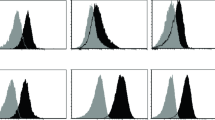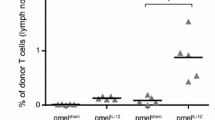Abstract
Recombinant human interleukin-2 (rhIL-2) therapy is approved for treating patients with advanced melanoma yet significant responses are observed in only 10–15% of patients. Interleukin-2 induces Foxp3 expression in activated human CD8 T cells in vitro and expands circulating CD8 Foxp3+ T cells in melanoma patients. Employing IL-2 responsive (B16-F1, B16-BL6, JB/MS, MCA-205) and nonresponsive (JB/RH, B16-F10) subcutaneous tumor mouse models, we evaluated CD8 Foxp3+ T cell distribution and changes in response to rhIL-2 (50,000 U, i.p. or s.q., twice daily for 5 days). In tumor-free mice and subcutaneous tumor-bearing mouse models, CD8 Foxp3+ T cells were a rare but naturally occurring cell subset. Primarily located in skin-draining lymph nodes, CD8 Foxp3+ T cells expressed both activated T cell (CD28+, CD44+) and Treg (CTLA4+, PD1lo/var, NKG2A+/var) markers. Following treatment with rhIL-2, a dramatic increase in CD8 Foxp3+ T cell prevalence was observed in the circulation and tumor-draining lymph nodes (TD.LNs) of animals bearing IL-2 nonresponsive tumors, while no significant changes were observed in the circulation and TD.LNs of animals bearing IL-2 responsive tumors. These findings suggest expansion of CD8 Foxp3+ T cell population in response to rhIL-2 treatment may serve as an early marker for tumor responsiveness to immunotherapy in an immune competent model. Additionally, these data may provide insight to predict response in patients with melanoma undergoing rhIL-2 treatment.






Similar content being viewed by others
References
Jemal A, Siegel R, Xu J, Ward E (2010) Cancer statistics, 2010. CA Cancer J Clin 60:277–300
Yang AS, Chapman PB (2009) The history and future of chemotherapy for melanoma. Hematol Oncol Clin North Am 23:583–597
Atkins MB, Lotze MT, Dutcher JP, Fisher RI, Weiss G, Margolin K, Abrams J et al (1999) High-dose recombinant interleukin 2 therapy for patients with metastatic melanoma: analysis of 270 patients treated between 1985 and 1993. J Clin Oncol 17:2105–2116
Riker AI, Radfar S, Liu S, Wang Y, Khong HT (2007) Immunotherapy of melanoma: a critical review of current concepts and future strategies. Expert Opin Biol Ther 7:345–358
Sparano JA, Fisher RI, Sunderland M, Margolin K, Ernest ML, Sznol M, Atkins MB et al (1993) Randomized phase III trial of treatment with high-dose interleukin-2 either alone or in combination with interferon alfa-2a in patients with advanced melanoma. J Clin Oncol 11:1969–1977
Taylor RC, Patel A, Panageas KS, Busam KJ, Brady MS (2007) Tumor-infiltrating lymphocytes predict sentinel lymph node positivity in patients with cutaneous melanoma. J Clin Oncol 25:869–875
Oble DA, Loewe R, Yu P, Mihm MC Jr (2009) Focus on TILs: prognostic significance of tumor infiltrating lymphocytes in human melanoma. Cancer Immun 9:3
Malek TR (2008) The biology of interleukin-2. Annu Rev Immunol 26:453–479
Waldmann TA, Dubois S, Tagaya Y (2001) Contrasting roles of IL-2 and IL-15 in the life and death of lymphocytes: implications for immunotherapy. Immunity 14:105–110
Ahmadzadeh M, Antony PA, Rosenberg SA (2007) IL-2 and IL-15 each mediate de novo induction of FOXP3 expression in human tumor antigen-specific CD8 T cells. J Immunother 30:294–302
Gavin MA, Torgerson TR, Houston E, DeRoos P, Ho WY, Stray-Pedersen A, Ocheltree EL et al (2006) Single-cell analysis of normal and FOXP3-mutant human T cells: FOXP3 expression without regulatory T cell development. Proc Natl Acad Sci USA 103:6659–6664
Fontenot JD, Gavin MA, Rudensky AY (2003) Foxp3 programs the development and function of CD4 + CD25+ regulatory T cells. Nat Immunol 4:330–336
Wildin RS, Smyk-Pearson S, Filipovich AH (2002) Clinical and molecular features of the immuno dysregulation, polyendocrinopathy, enteropathy, X linked (IPEX) syndrome. J Med Genet 39:537–545
Torgerson TR, Ochs HD (2007) Immune dysregulation, polyendocrinopathy, enteropathy, X-linked: forehead box protein 3 mutations and lack of regulatory T cells. J Allergy Clin Immunol 120:744–750 (quiz 751–742)
Fidler IJ (1973) Selection of successive tumour lines for metastasis. Nat New Biol 242:148–149
Nakayama J, Urabe K, Tsuchida T, Urabe A, Terao H, Taniguchi S, Hori Y (1995) Differential cell- and immuno-biological properties of murine B16-F1 and F10 melanomas: oncogene c-fos expression, sensitivity to LAK cells and/or IL-2, and components of gangliosides. J Dermatol 22:549–559
Berkelhammer J, Luethans TN, Hook RR Jr, Oxenhandler RW (1986) Phenotypic instability of mouse melanomas after propagation in vivo and in vitro. Cancer Res 46:2923–2928
Rosenberg SA, Schwarz SL, Spiess PJ (1988) Combination immunotherapy for cancer: synergistic antitumor interactions of interleukin-2, alfa interferon, and tumor-infiltrating lymphocytes. J Natl Cancer Inst 80:1393–1397
Cortesini R, LeMaoult J, Ciubotariu R, Cortesini NS (2001) CD8 + CD28- T suppressor cells and the induction of antigen-specific, antigen-presenting cell-mediated suppression of Th reactivity. Immunol Rev 182:201–206
Sauer S, Bruno L, Hertweck A, Finlay D, Leleu M, Spivakov M, Knight ZA et al (2008) T cell receptor signaling controls Foxp3 expression via PI3K, Akt, and mTOR. Proc Natl Acad Sci USA 105:7797–7802
Mayer CT, Floess S, Baru AM, Lahl K, Huehn J, Sparwasser T (2011) CD8 + Foxp3+ T cells share developmental and phenotypic features with classical CD4 + Foxp3 + regulatory T cells but lack potent suppressive activity. Eur J Immunol 41:716–725
Dutton RW, Bradley LM, Swain SL (1998) T cell memory. Annu Rev Immunol 16:201–223
Suciu-Foca N, Berloco P, Cortesini R (2009) Tolerogenic dendritic cells in cancer, transplantation, and autoimmune diseases. Hum Immunol 70:277–280
Munn DH, Sharma MD, Hou D, Baban B, Lee JR, Antonia SJ, Messina JL et al (2004) Expression of indoleamine 2,3-dioxygenase by plasmacytoid dendritic cells in tumor-draining lymph nodes. J Clin Invest 114:280–290
Faunce DE, Terajewicz A, Stein-Streilein J (2004) Cutting edge: in vitro-generated tolerogenic APC induce CD8 + T regulatory cells that can suppress ongoing experimental autoimmune encephalomyelitis. J Immunol 172:1991–1995
Acknowledgments
This work was supported in part by a grant from The Carolinas Healthcare Foundation (DMF). JB/MS and JB/RH were donated by Dr. Esteban Celis (H. Lee Moffitt Cancer Center, Tampa FL). The MCA-205 cell line was a generous gift from Dr. Alfred Chang (University of Michigan, Ann Arbor, MI). Highly purified rhIL-2 was a gift from Chiron Corporation (Emeryville, CA). We thank Perla Nunes for technical assistance with flow cytometry.
Author information
Authors and Affiliations
Corresponding author
Electronic supplementary material
Below is the link to the electronic supplementary material.
Rights and permissions
About this article
Cite this article
Foureau, D.M., McKillop, I.H., Jones, C.P. et al. Skin tumor responsiveness to interleukin-2 treatment and CD8 Foxp3+ T cell expansion in an immunocompetent mouse model. Cancer Immunol Immunother 60, 1347–1356 (2011). https://doi.org/10.1007/s00262-011-1035-1
Received:
Accepted:
Published:
Issue Date:
DOI: https://doi.org/10.1007/s00262-011-1035-1




